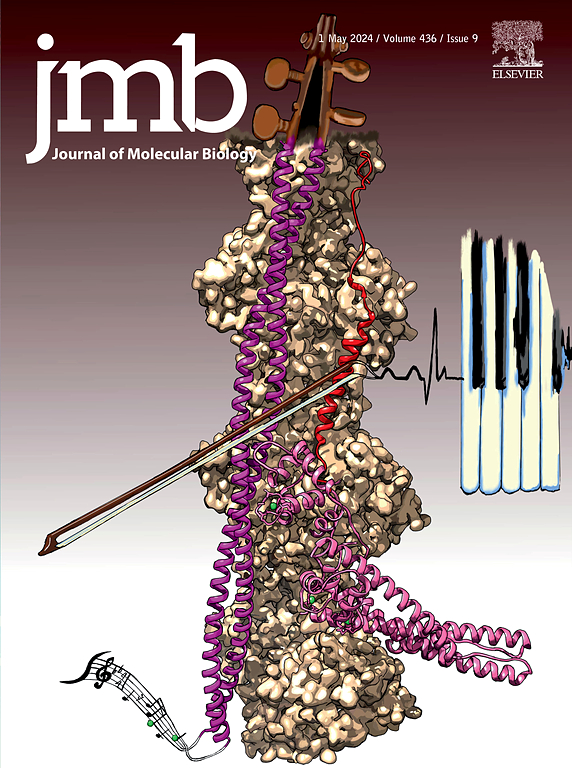Structure and Mechanism of Aminoacyl-tRNA-Protein L/F- and R-transferases
IF 4.5
2区 生物学
Q1 BIOCHEMISTRY & MOLECULAR BIOLOGY
引用次数: 0
Abstract
The aminoacyl-tRNA-protein transferases (also known as aa-transferases) are a class of enzymes that utilize a highly conserved GCN5-related N-acetyltransferase (GNAT) fold to catalyze the post-translational transfer of amino acids from an aminoacylated transfer RNA (tRNA) to an acceptor protein. The two most important subclasses of aa-transferases are the prokaryotic L/F-transferases and the eukaryotic R-transferases (ATE1s). Both subclasses were initially discovered as early as the 1960s, and both share an overlapping function linked to protein degradation: L/F-transferases are known to modify proteins that are ultimately targeted for degradation via the Clp proteolytic pathway, while R-transferases (ATE1s) are known to modify proteins that may be targeted for degradation by the ubiquitin proteasome system (UPS), although many non-degradative fates may also occur. While L/F-transferases have been minimally explored at the cellular level, the R-transferases (ATE1s) have had extensive studies linking them to critical cellular functions. Despite over a half a century passing since their discoveries, X-ray crystallographic and cryo-EM studies have only recently begun to shed light onto the mechanism of these enzymes. This review underscores the functional importance of L/F- and R-transferases (ATE1s) and highlights the recent structural developments in this field with a particular emphasis on the eukaryotic R-transferases (ATE1s). Additionally, this review draws on current structural information to synopsize proposed catalytic and regulatory mechanisms for these enzymes. Finally, this review highlights important structural and mechanistic knowledge gaps in aa-transferase function that should be addressed in order to target these important enzymes for future therapeutic developments.

氨基酰基trna -蛋白L/F-和r -转移酶的结构和机制。
氨基酰基-tRNA-蛋白转移酶(也称为aa-转移酶)是一类利用高度保守的gcn5相关n -乙酰基转移酶(GNAT)折叠来催化氨基酸从氨基酰化转移RNA (tRNA)到受体蛋白的翻译后转移的酶。aa转移酶的两个最重要的亚类是原核L/ f转移酶和真核r转移酶(ATE1s)。这两个亚类早在20世纪60年代就被发现,它们都具有与蛋白质降解相关的重叠功能:已知L/ f转移酶修饰最终通过Clp蛋白水解途径降解的蛋白质,而已知r转移酶(ATE1s)修饰可能被泛素蛋白酶体系统(UPS)降解的蛋白质,尽管许多非降解的情况也可能发生。虽然L/ f转移酶在细胞水平上的研究很少,但r -转移酶(ATE1s)已被广泛研究,将它们与关键的细胞功能联系起来。尽管他们的发现已经过去了半个多世纪,但x射线晶体学和低温电镜研究直到最近才开始揭示这些酶的机制。本文综述了L/F和r -转移酶(ATE1s)的功能重要性,并重点介绍了该领域的最新结构进展,特别是真核r -转移酶(ATE1s)。此外,本综述利用当前的结构信息来概述这些酶的催化和调控机制。最后,本综述强调了aa转移酶功能中重要的结构和机制知识空白,这些空白应该得到解决,以便针对这些重要的酶进行未来的治疗发展。
本文章由计算机程序翻译,如有差异,请以英文原文为准。
求助全文
约1分钟内获得全文
求助全文
来源期刊

Journal of Molecular Biology
生物-生化与分子生物学
CiteScore
11.30
自引率
1.80%
发文量
412
审稿时长
28 days
期刊介绍:
Journal of Molecular Biology (JMB) provides high quality, comprehensive and broad coverage in all areas of molecular biology. The journal publishes original scientific research papers that provide mechanistic and functional insights and report a significant advance to the field. The journal encourages the submission of multidisciplinary studies that use complementary experimental and computational approaches to address challenging biological questions.
Research areas include but are not limited to: Biomolecular interactions, signaling networks, systems biology; Cell cycle, cell growth, cell differentiation; Cell death, autophagy; Cell signaling and regulation; Chemical biology; Computational biology, in combination with experimental studies; DNA replication, repair, and recombination; Development, regenerative biology, mechanistic and functional studies of stem cells; Epigenetics, chromatin structure and function; Gene expression; Membrane processes, cell surface proteins and cell-cell interactions; Methodological advances, both experimental and theoretical, including databases; Microbiology, virology, and interactions with the host or environment; Microbiota mechanistic and functional studies; Nuclear organization; Post-translational modifications, proteomics; Processing and function of biologically important macromolecules and complexes; Molecular basis of disease; RNA processing, structure and functions of non-coding RNAs, transcription; Sorting, spatiotemporal organization, trafficking; Structural biology; Synthetic biology; Translation, protein folding, chaperones, protein degradation and quality control.
 求助内容:
求助内容: 应助结果提醒方式:
应助结果提醒方式:


